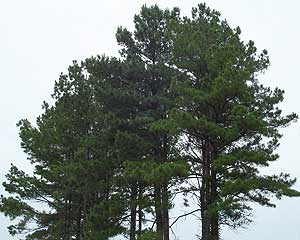
Loblolly pines, photo courtesy Benjamin D. Bartlett
Loblolly pine (Pinus taeda L.) is an organism of tremendous economic and ecological
importance and a key representative of the conifers, an ancient lineage of plants that dominates many of the world’s temperate and boreal ecosystems. Loblolly pine’s fast growth, amenability to intensive tree farming, and high-quality lumber/pulp have made it the cornerstone of the U.S. forest products industry and the most commonly planted tree species in America; approximately 75% of all seedlings planted each year are loblolly pines. Its ability to efficiently convert CO2 into biomass and its widespread use as a plantation tree have also made loblolly pine a cost-effective feedstock for lignocellulosic ethanol production and a promising tool in efforts to curb greenhouse gas levels via carbon sequestration. Despite the importance of loblolly pine and other conifers, genomic sequence information for this taxon is extremely limited. EST resources are available as a result of sequencing efforts at JGI and elsewhere, but actual genomic DNA sequence data is needed to enable efficient tree improvement. JGI plans to sequence 100 clones from an existing BAC library. Of these clones, 50 will be selected based on the presence of genes involved in carbon metabolism and/or wood formation, 25 will be chosen based on low repeat content, and 25 will be picked at random. BAC sequencing will provide unprecedented insight into genome organization in loblolly pine and conifers in general.
Principal Investigators: Daniel G. Peterson (Mississippi State Univ.), Jeffrey F.D. Dean (Univ. of Georgia), C. Dana Nelson (USDA Forest Service), Ronald R. Sederoff (North Carolina State Univ.), and Daniel S. Rokhsar (JGI).
Program: CSP 2009